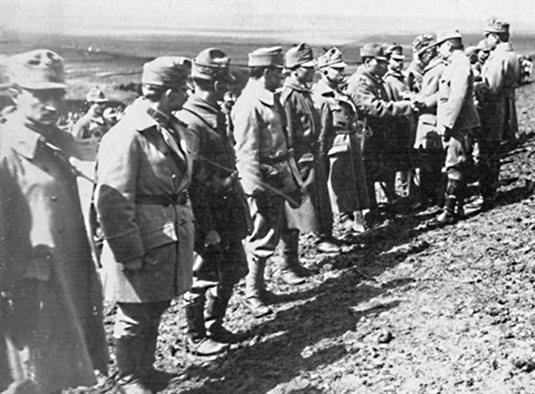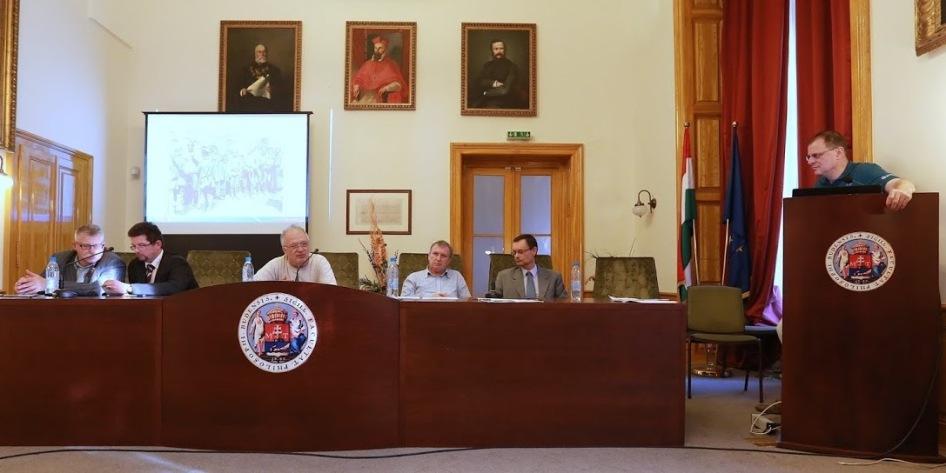
Heroes, martyrs, victims and historical figures – all would have a place in the hall of heroes, if that country still existed with the borders they helped to defend with all the other fighting men.
Prime Minister Count István Tisza, who 100 years ago tendered his resignation on the order of the Austro-Hungarian sovereign, and then left for the front to fight. One year later he was assassinated in his home during the Aster Revolution.

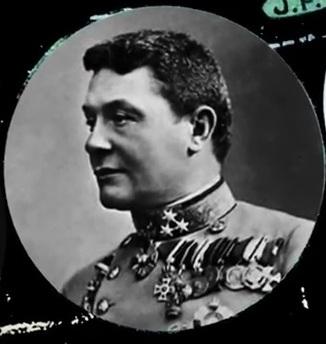
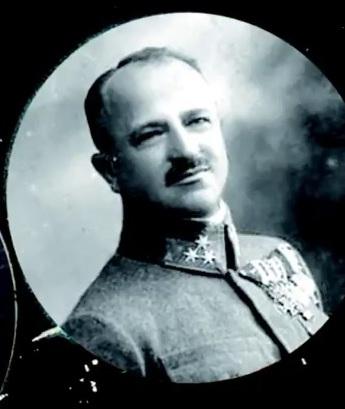
 Admiral Miklós Horthy in the middle of May in 1917 was victorious at Otranto on the Adriatic sea.
Admiral Miklós Horthy in the middle of May in 1917 was victorious at Otranto on the Adriatic sea. Hermann Kövess captured Belgrade in 1915 and in 1917 recaptured Bukovina from the Russians.
Hermann Kövess captured Belgrade in 1915 and in 1917 recaptured Bukovina from the Russians. Károly Kratochvil was victorious on the Italian front at Isonzo, also 100 years ago.
Károly Kratochvil was victorious on the Italian front at Isonzo, also 100 years ago.
Horthy, Kövess, Kratochvil – all were recipients of the Maria Theresa Military Order of 1917.
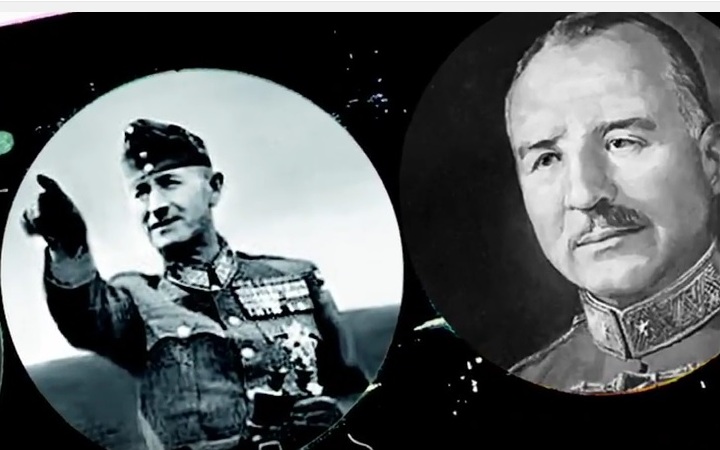
Ferenc Szombathelyi who with Henrik Werth not only fought throughout the First World War, and the Soviet Republic of Hungary, but also throughout the Second World War, as both were commander-in-chiefs of the Hungarian Army. True, more than 20 years after the First World War.
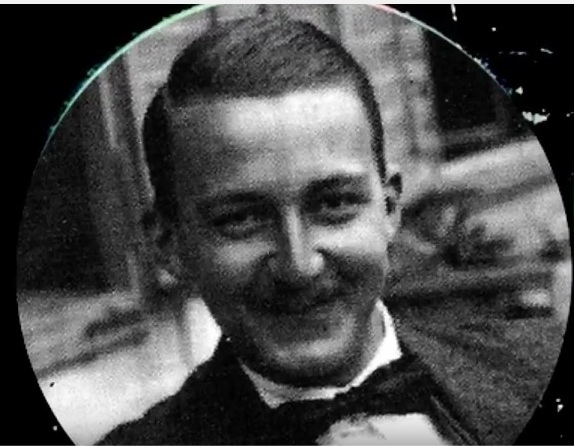
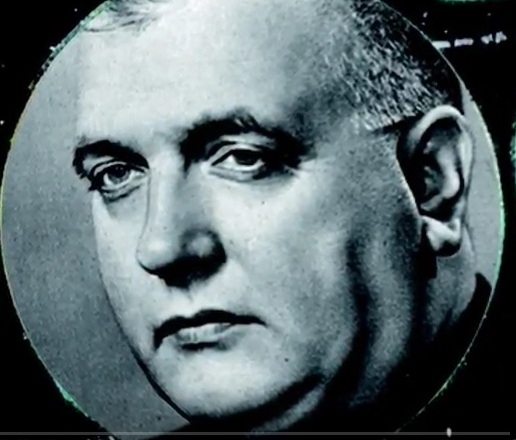
Finally Count János Esterházy, politician and martyr who was charged and sentenced to death under the same legal paragraph as his political opponent, Joseph Tiso, who had served as a military chaplain in the First World War and who was executed in 1947, even though it was he who had created the independent Slovak state.
Life histories full of contradictions, and important lessons for today.
For futher contemplation an Aspektus evening of debate was organized with the participation of Russian historian Sergei Nelipovich – the director of the Balashiha Municipal Government’s Archival Department in Moscow.
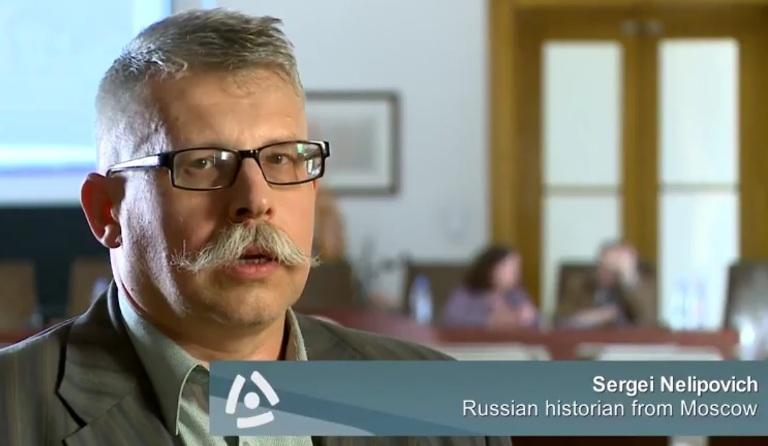
Sergei Nelipovich, Russian historian from Moscow:
Having lost 2 million soldiers by the fall of 1916, the Russian army proved to be incapable of crushing the military strength of the Central Powers. The Austro-Hungarian and German military divisions, supported by the Ottoman and Bulgarian troops, had successfully resisted and succeeded even in conquering Romania, which had intervened on the side of the Entente. By then, at least for the Russian Empire, the chance for victory seemed as remote as it had been in 1914.
Furthermore, the peace proposals drafted by the Germans at the end of 1916, contrary to all the other warring parties, specifically favored Russia as they did not include any elements which would have questioned the sovereignty of the Russian state.
In November of 1916 for the Central Powers, the recognition of Polish independence would have resulted in the borders of Russia being subject to open debate, even in the event of an Entente victory. It became clear then, that the Russian Empire would not be able to maintain Russian Poland within the borders of Russia, neither as a victorious, nor as a defeated party.
One of the primary reasons for this was the outbreak of the first Russian revolution in February 1917, which had in fact begun as a military coup. The garrison of the capitаl stood up along with the dissatisfied, grumbling population of Petrograd, protesting against the poor provision of supplies for the city. Otherwise, the police forces would have easily dispached with the smoldering unrest rising to the surface.
In addition, the tops ranks of the army, the commanders on the front did everything possible to strip the Czar from power. There was even talk of arresting him.
At the same time, however, all the participants of this military coup, including the liberal opposition, thought that they would be successful where the Czar had not been, that they would succeed in ending the war in victory.
The so-called ”Guchkov cleansing” of much of the Russian military leadership was named after Guchkov, the minister of war for the Provisional Government. 500 top ranking Russian officers were served their discharge papers in the spring of 1917.
That summer the Provisional Government ordered the army to begin what later become known as the Kerensky Offensive in the Soviet historical narrative, which in reality was lead by General Brusilov.
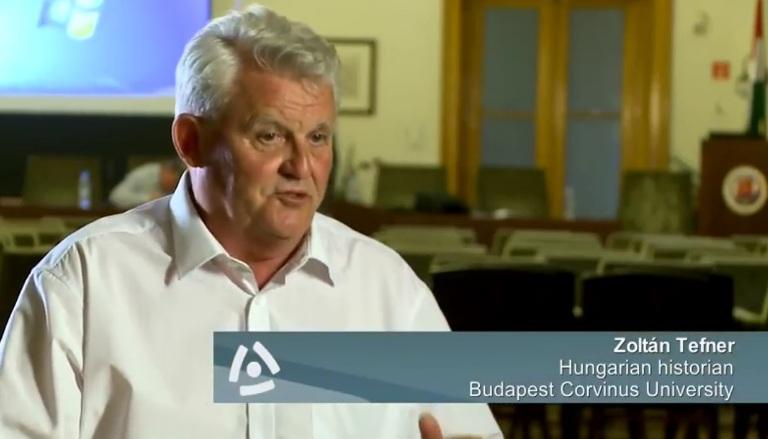
Zoltán Tefner, Hungarian historian, Budapest Corvinus University:
The aged Franz Joseph passed away on November 21st of 1916 bringing a new sovereign. Change came in foreign diplomacy and internal relations. The new dual foreign minister, Ottokar Czernin had been a prominent member of the Belvedere Group and represented the teachings, the theories and the plans of Franz Ferdinand who was assassinated in Sarajevo. He was essentially Tisza’s collegue, one could use this expression friend, although their relationship wouldn’t have allowed that, and an entirely new foreign policy of peace began to take shape. Czernin tried to persuade the Germans to attempt a separate peace. By this Germany would relinquish Belgium and reinstate its independence. Alsace-Lorraine, which had been part of German terroritory since 1870, would be ceded to France.
Naturally, Germany wasn’t having any of this, while at the same time the armies were completely exhausted. Later Italian Commander-in-chief Luigi Cardona is replaced, and there was a complete replacement of the leadership of the Habsburg Monarchy as well.
The authoritarian, dynamic Commander-in-chief Conrad von Hötzendorf, one of the main proponents of the war, was replaced by a Transylvanian Saxon, General Arthur Arz, who was moderately friendly to the Hungarians and ended up passing away in Budapest in the 1930’s. A totally new policy was also initiated in the army and in military relations.
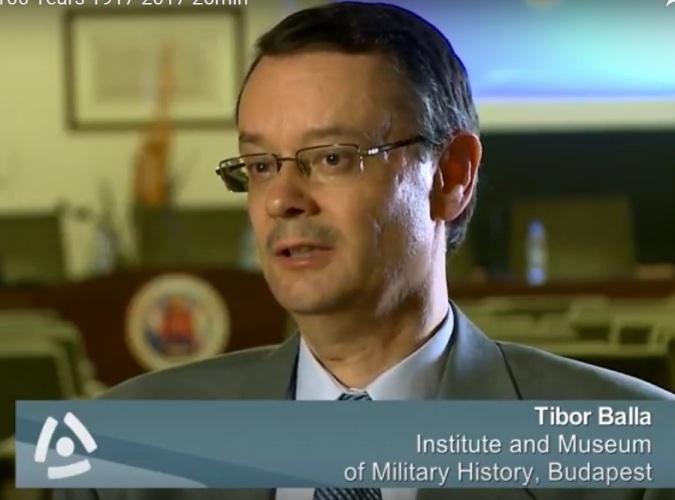
Tibor Balla, Hungarian historian of Military History Institute and Museum, Budapest:
1917 was the year of achievements and ended up being the most successful year for the Central Powers in the progression of the war. With the Battle of Caporetto the breakthrough at the Italian front was the most decisive military operation to succeed, albeit with German aid. If we look at the exact figures, the 37 military divisions to execute the breakthough were opposed by 41 defensive Italian divisions. These divisions employed a new tactic introduced by the Germans which was that, in lieu of attacking the enemy where they were – on the top of the mountains – the plan was to advance from the valley below. Then surround the enemy which would soon surrender, and then retreat quickly from the mountains to the Po plains ahead and breakthrough and not stop until Tagliamento, bacause that was the objective. No one counted on what actually followed, which was Piave.
Sergei Nelipovich, Russian historian from Moscow:
Brusilov was one of the proponents of a general advance and overall plan of Russian attack. He had shared this plan, already in December of 1916, with the acting Russian Commander-in-Chief, the Czar. He then modified his plan in the spring of 1917. He thought to liberate Romania, bring Bulgaria to its knees, completely destroy Austro-Hungary and force Germany to make a peace all in one blow. This plan was completely out of touch with reality. He didn’t take into account the actual balance of power.
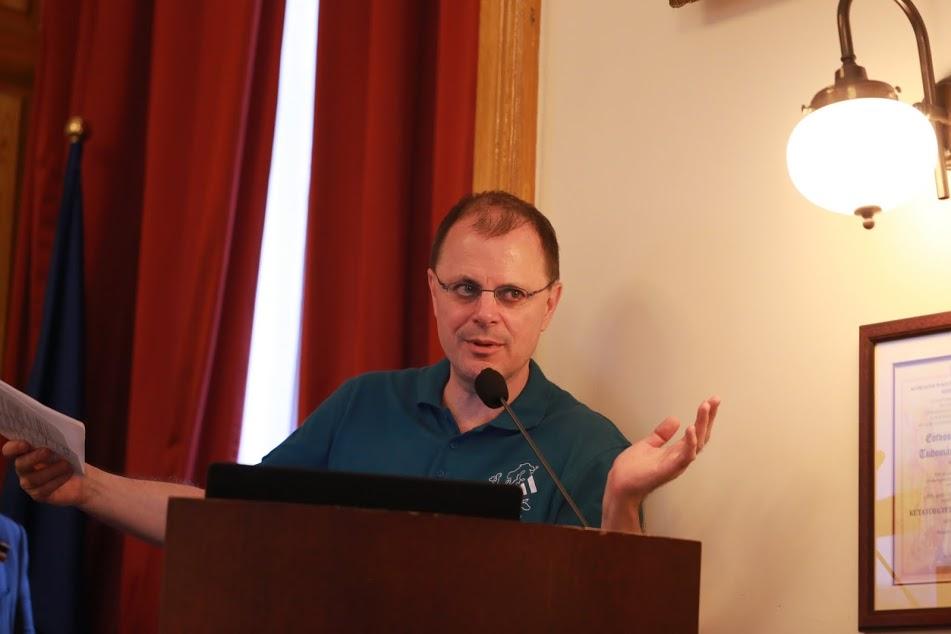
 Géza Gecse, Aspektus project director:
Géza Gecse, Aspektus project director:
It seems you don’t have a very high opinion of Brusilov despite the fact that his reputation in the international academic texts on the subject is that both the Wehrmacht and the Red Army employed Brusilov’s military strategy of World War I successfully in World War II.
Sergei Nelipovich, Russian historian from Moscow:
Brusilov got his idea for the 1916 offensive from the French military operation in the fall of 1915. There was nothing unique about it. The Brusilov plans of both 1916 and 1917 counted on Austria-Hungary being destroyed in these battles.
He was mistaken.
For one, he underestimated the strength of his enemies, and for another, he had not noticed that the methods of war had changed from 1914. If the enemy retreats, it would be strengthened and entrenched in the new attacking positions.
This was what the Russian army, prepared to attack in 1917, had to confront as well.
Contrary to the year 1916, in 1917 the Central Powers were able to exact a few counterattacks against the advancing Russian forces. Such was the breakthough of the Russian lines at Tarnopol. The loss of the lives of a half a million Russian soldiers proved to be in vain in the Russian military operation from the Dvina River to the Black Sea.

Brusilov was unable to attain his goal, and politicians were beginning to use the army for their own political objectives. The army’s capability was no longer important but instead how foreign political objectives were being interpreted by the various political movements.
Following the fall of Riga, Prime Minister Kerensky used this defeat to name himself commander-in-chief of the Russian army. From this time forward the soldiers elected the leading officers of the army and organized revolutionary committees.
Taking into consideration that the confidence of the soldiers in the officers was now shaken, these committees played a certain consolidating role. The revolutionary military committees procured extraordinary powers and soon became the most powerful element in the army.
It became apparent that: not only would it be impossible to exit the war through military means, but also that the varying positioning of the political movements would be able to be decided by the army. The soldiers elected those leaders they could trust, and they sided with those who promised peace and land, as the Bolsheviks did that autumn. Dukhonyin, the new commander-in-chief tried to keep secret the events of Petrograd for a week, until it was no longer possible.
Zoltán Tefner, Hungarian historian, Budapest Corvinus University:
They replaced the dual foreign minister István Burian. Many say he was the long arm of István Tisza, which is partly true. Then Tisza himself is replaced which results in great fluctuation in the line of the Hungarian prime ministers up unto Wekerle in 1918.
The year 1917 brought with it the great changes resulting from the Bolsheviks seizing power in Saint Petersburg.
Sergei Nelipovich, Russian historian from Moscow:
It’s a completely different matter that a Russian civil war followed the outbreak of the Bolshevik revolution. Not only did human life lose its value in the wake of the First World War, but the individual himself was lost as well.
And the civil war was far more brutal than even the world war and brought more casualties with it than traditional warfare.
Géza Gecse, Aspektus project director:
How can the Bolshevik coup be interpreted from a military perspective?
Sergei Nelipovich, Russian historian from Moscow:
From a military perspective one can say that a peaceful exit of the war was won in the fall of 1917. The country was totally embittered by then. The ruling opinion of the revolutionary military committees was the following: We condemn the violent overthrow of power by the Bolsheviks, but we support their leadership as there was no other leadership in the country.
Tibor Balla, Hungarian historian of Military History Institute and Museum, Budapest:
Bukovina is liberated by the Austro-Hungarian troops, clearly with German aid, because in 1917 it would have been impossible otherwise. Interesting, and I often emphasize this, that the Germans are present in all the greater military operations, such as those at Gorlice, Caporetto and in the Romanian offensive. Without German aid, experience, discipline and military technology the army of the Monarchy would have been often in great difficulty.
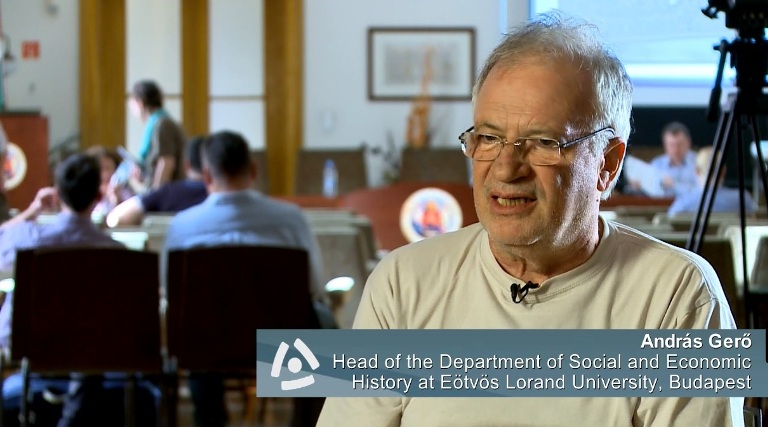
 András Gerő, Head of the Department of Social and Economic History at Eötvös Loránt University, Budapest:
András Gerő, Head of the Department of Social and Economic History at Eötvös Loránt University, Budapest:
The First World War, which combined both the continuity of the past and the deviation from the present, brought in the aspect of remembrance, as it involved masses of people – the entire thing, and I can’t put it any other way, the whole thing became democratized. Something had to be done with the fact that hundreds of thousands of people were dying and another several hundred thousand were injured just on the Hungarian side, as all over Europe as well. Millions died and were injured. And many more millions were affected by this.
The loss of the head of the family, the loss of a son, these all meant family tragedies and as such this became a mass experience, which is why I said the war became democratized as an experience.
It was no longer a battle between aristocrats and their noble orders, and the result was the need for the simple soldier to be elevated to a pedestal. Not only the officers, but the soldiers in grey uniform and by 1917 there were several hundreds of thousands of them dead.
This came with the idea that had been formulated in 1915 for the need of some sort of memorial for these men in every community from which a solder had entered the army and had fallen from enemy fire. This is what was codified in 1917 in Hungary.
Géza Gecse, Aspektus project director:
The first state leader of an independent Slovakia, its creator if you like, Joseph Tiso, participated in the First World War, by his official name as Tiszó József. He, neither, is judged by public opinion according to his achievements during World War I.
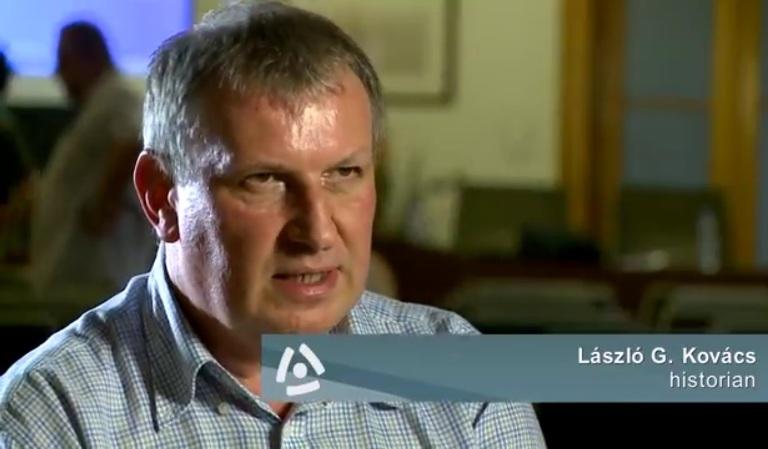
 László G. Kovács, Hungarian historian from Budapest:
László G. Kovács, Hungarian historian from Budapest:
Joseph Tiso had seen the battlefield in Galicia up close,and he had been in military service in Slovenia. He became ill towards the end of 1914, and from the beginning of 1915 he was in Nitra, and that is where the end of the war found him. From that time on he did not come near the front nor did he serve any longer in the army, but he had seen the horrors of the war in Galicia which he reported in perfect Hungarian in a series of articles in the Nitra County Gazette. There had been mass recruitment amongst the Slovaks as well, as with every other nationality in the Kingdom of Hungary in pre-war Hungary. Slovak soldiers had been present in the First World War in the Eastern and Balkan war zones, as well as in Italy. The Slovak national remembrance, as well as their historical narrative, see these soldiers as victims.
Géza Gecse, Aspektus project director:
It’s rather absurd, isn’t it, that Count János Esterházy martyr and politician, who was tried under the same trumped up charges as his political opponent Joseph Tiso, has not been rehabilitated in Slovakia to this day.
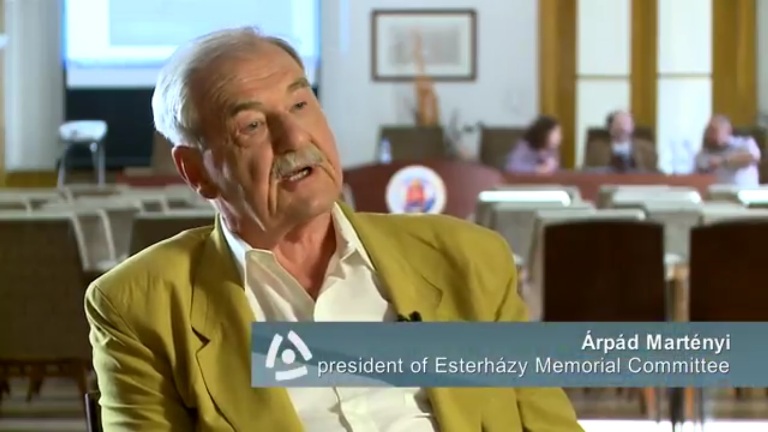
Árpád Martényi, president of Esterházy Memorial Committee:
This is truly a paradox. In Slovakia Count János Esterházy is seen even today as a war criminal; whereas, we Hungarians view him as a hero. My father was a lawyer in Presov and was the leader of the Hungarian Party there and as such was a close colleague of Esterházy’s until his arrest in 1945. He was active on the Czechoslovak, then the Slovak national political scenes where he represented the interests of the Hungarian minority.
Then, following his arrest in 1945, Esterházy was taken to the Soviet Union and tried and sentenced to death in absentia in Czechoslovakia. He had defended the interests of the Hungarians from 1933 to 1945, for 12 years, in the Czech and the Slovak parliaments as a member of parliament, as well as the leader of the Hungarian Party. Then he suffered for 12 years without trial in prisons in the Soviet Union and in Czechoslovakia.
Géza Gecse, Aspektus project director:
It’s incredible, isn’t it, that Joseph Tiso and Count János Esterházy were taken to court and tried under the same law.
László G. Kovács, Hungarian historian from Budapest:
Unfairly, because Joseph Tiso was justly brought to trial as a war criminal. He was responsible for war crimes as he was the leader of the Slovak state in existence from 1919 to 1945. He was the most influential politician, as well as representing the moral standard of the country as he was a man of the church, a priest. The majority of the Slovak people, being a strongly religious people, took as religious doctrine, or at least very seriously, everything that Tiso said.
Therefore, he was responsible for all of Slovakia’s actions during the Second World War including participating in the attack of the Soviet Union by Germany and also for everything which had occurred internally in Slovakia – primarily the deportation of the Jews of Slovakia, which ended in a massacre, as well as the crushing of the Slovak National Uprising and the brutalities which followed.
Joseph Tiso with his regime and military staff, was truly the last satellite of Germany, and, as with the Hungarian Arrow Party leadership, he also escaped to Germany. And they stood by the Germans to the very end, almost to capitulation.
Conversely, János Esterházy cannot be accused of having committed any sort of war crime. They charged him on two charges and those we two charges completely trumped up and the entire thing was a show trial.
The first charge was that as a revisionist Hungarian politican he made an alliance with the Sudeten Germans who served the goals of the Third Reich in 1938, allied with Hlinka’s Slovak autonomist party, the Slovak People’s Party, and as such Esterhazy was charged as being one of the primary individuals responsible for the break-up of Czechoslovakia. In addition, they charged him with playing a prominent role in constructing and directing Tiso’s regime, which was labeled fascist; whereas Esterházy was in clear opposition to this regime.
Think freely about these questions, up unto the present, as it is not only the goal of our small clip competition, but also of life not to repeat past mistakes. We hope to see historically informative clips of 2-4 minutes and now we have the experiences of two successful years to build on. Our colleagues and our winning applicants are ready to help.
András Meszáros, secondary school teacher, Bicske:
The ease of the technology of making films on this subject is very alluring, and we are asking for the help of teachers and the school directors for this project.
Gábor Dombovári, president of KÉK Association:
I think that today’s youth needs instruction. I’m not sure that they always feel what needs to be done. I’m not saying that we need to tell them what they should do, but we need to provide some sort of framework or outline, and if this is done, we will get a better quality of submissions.
András Meszáros, secondary school teacher, Bicske:
The other thing is more of a type of play, such as something starting with a weapon or a map found in a museum or passed on to generations within a family or with one of the many class trips. From these examples the task is really easy. Often the students don’t even understand how easy it is.
Balázs Lados, History teacher at Saint Margaret Secondary School, Budapest:
Today’s youth can handle less work than even those of 10 to 12 years ago. Textbook information has to be apportioned in ever smaller doses, and the play and entertainment aspect has to be emphasized evermore.
Géza Gecse:
Ágoston Sándor, 11th grade secondary school student from Budapest and first prize winner of the 2016 Aspektus short film competition.
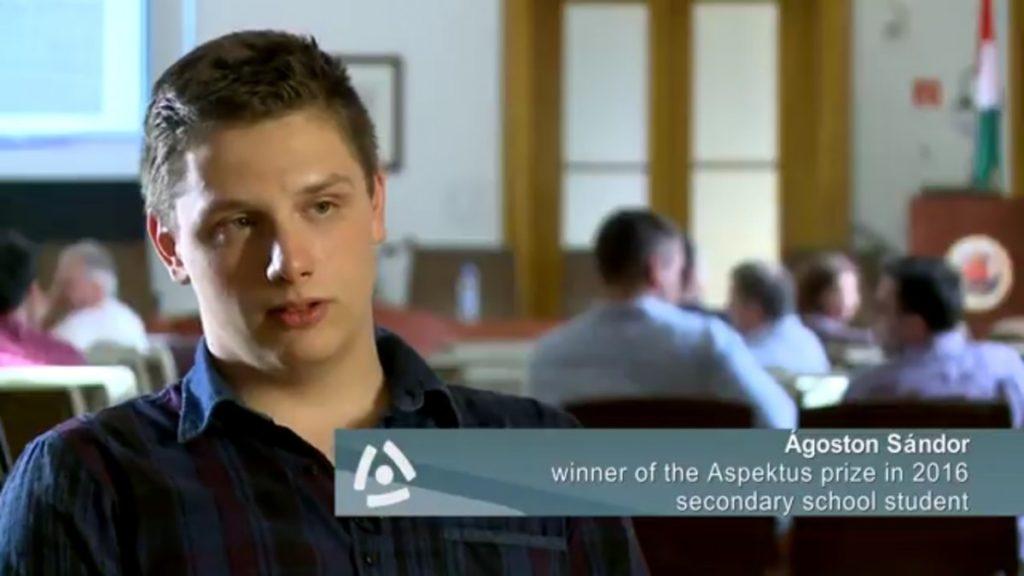
Ágoston Sándor:
I noticed that it’s information in video games and documentary films which reaches young people whether or not it is consciously or subconsciously noticed by them: the gunfire game, for instance, on World War I. One notices things which could be important; they could be in documentary films or even commercial films.
I made it in black and white so that it would seem as if it were archival footage.
’The First World War, which took place between 1914 and 1918, was one of the most significant and most destructive wars in world history.
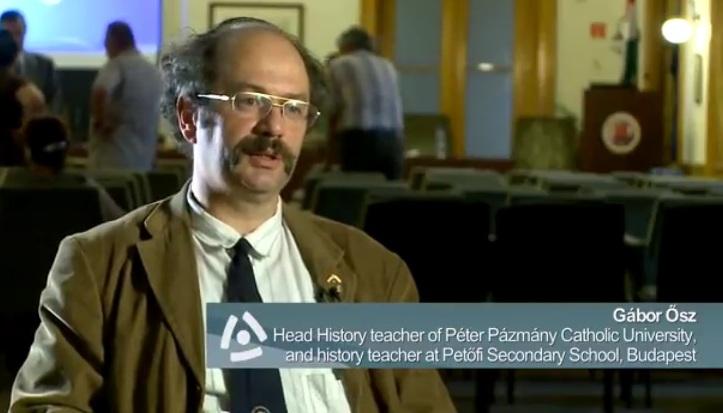
Gábor Ősz, Head History teacher of Péter Pázmány Catholic University, and history teacher at Petőfi Secondary School, Budapest:
The themes need to be expanded upon. Other than the war, the background of the home country needs to be explored, the life of the simple man or woman. We should be considering the fact that the historical profession is employing an ever increasing number of women. Those young women, for instance, who are interested in history but less interested in the horrors of the war, could concentrate on the life of a young female student during the war. These would be a very interesting aspect to the project, and in this way we could explore the historical perspective of the lifestyle and mentality of the time.
Éva Róth Hutvagner, Secondary school teacher, Dunaújváros:
Now we have samples to show them so they shouldn’t find the task as daunting. This is what the others have produced; you could do something similar.
János Csordás, Ágoston Sándor’s secondary school teacher, Budapest:
Agoston’s success proved to me that, on the one hand, students can be not only participants in learning history, but creators in this process as well, and, on the other hand, what possibilities are out there to combine history and information technology and how the tools for teaching history can be expanded. A personal story, a micro story, can help students in coming closer to history, and this is also an objective of education.
Géza Gecse, Aspektus project director:
The Great War in the reflection of 100 years: 1917-2017. We are accepting 2-4 minute short films until December 31, 2017. Submission: email: [email protected](link sends e-mail), Aspektus facebook page.
The whole 25 minutes film can be watched, by clicking here:
https://www.youtube.com/watch?v=dx2OPJHlv7Q(külső hivatkozás)
Good luck!
Géza Gecse and Juliet Szabó


